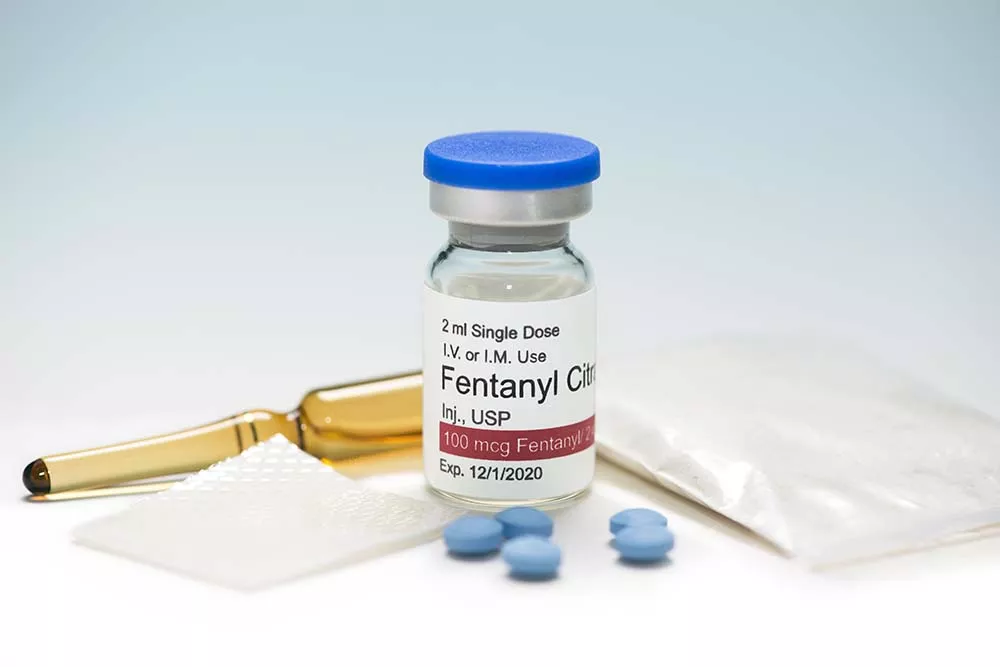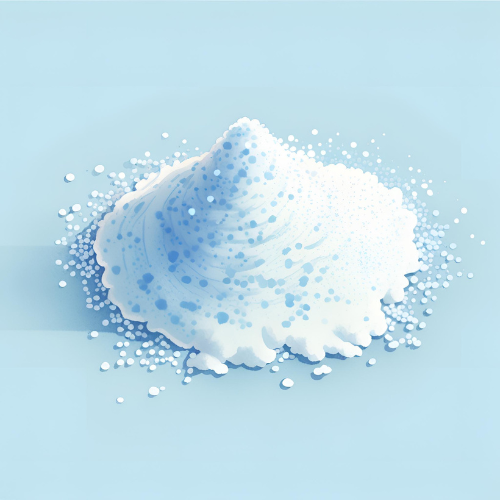Fentanyl is often added to black market stimulant drugs to make them stronger. Because fentanyl is very powerful, only a small dose is required to “enhance” the effects of the drug. This is also what makes it dangerous, as it’s possible to overdose by taking a small amount of fentanyl (about 2 mg).
Many fake prescription medications and illegal drugs are laced with fentanyl, but people aren’t always aware of it. If you have obtained medication that did not come from a pharmacy or your doctor, there’s a chance it could have fentanyl. Illegal drugs like heroin, cocaine and metamphetamines are often mixed with fentanyl as well.
Fentanyl is responsible for a big part of overdose cases and overdose deaths in the United States. This is known as the “fentanyl crisis”. In 2016, two thirds of all fentanyl overdose cases were caused by people taking fake prescription medication they bought from friends or dealers.

Fentanyl is a synthetic opioid that is incredibly powerful. It’s 100 times stronger than morphine and 50 times stronger than heroin. It’s approved by the FDA for pain management in cases of severe pain. Fentanyl is often prescribed to patients of advanced stage cancer, or after major surgeries.
FDA-approved fentanyl is called pharmaceutical fentanyl and is strictly controlled. It is available in several forms, including patches, lozenges, and injections. Most of the fentanyl found in the black market, however, is illegally produced and distributed. Black market fentanyl often appears in powdered form, as a liquid, or pressed into counterfeit pills.
Fentanyl lacing refers to the practice of mixing fentanyl with other substances like coke, MDMA, and fake prescription pills. In addition to altering the effects of other drugs, fentanyl lacing also reduces production costs behind trafficking illegal drugs, like cocaine. Cocaine (typically in powder form) can be cut with Fent in order to make the production cost cheaper without sacrificing its strength, but the risk of overdose increases drastically.
People that make counterfeit medication often mix fentanyl with drugs (like tramadol, diazepam and aspirin) and even household products. Fake prescriptions laced with fentanyl are on the rise during the current fourth wave of the opioid crisis. Both the fake prescription and the fentanyl are made together, illegally, and then distributed as a legal medication. They shape the pills to resemble legitimate medications and sell them online or through dealers. Sometimes, these pills also contain other illegal substances like heroin, cocaine, and methamphetamine.

FTS are small, paper-based strips that can detect fentanyl in different forms, including powders, pills, and injectables. Fentanyl test strips are not foolproof. A counterfeit pill could have fentanyl in it, but the strip won’t detect it if you are not testing the specific part of the pill that has fentanyl. This is because counterfeit pills are not evenly mixed. This is called the “chocolate cookie effect”. Like chocolate chips, fentanyl in fake pills is often not wholly mixed but scattered and concentrated in different parts.
Despite not being 100% accurate, FTS can be very useful. Though they are banned in some states, efforts are being made to make them more available throughout the US. They are also fairly inexpensive.
The US has been going through an opioid overdose epidemic for the last 25 years, which has four “waves” so far. The first one was prescription opioid use, followed by heroin and then synthetic opioids like fentanyl. The current fourth wave is driven by stimulants and opioids.
Fentanyl mixed with cocaine or methamphetamine is the main culprit behind the fourth wave. Co-occurring mental health disorders like anxiety and depression are also closely associated with stimulant/fentanyl use. While overdose cases have been decreasing in recent years, it’s still a major concern.

Fentanyl is cheaper to produce than many other drugs. This allows dealers to cut costs and make more money. Because of the effects it produces, fentanyl makes up for the “shortage” of the other drug.
Fentanyl is highly addictive due to its power and the rapid onset of its effects. Compared to other opioids, it produces a more intense euphoria and a sense of well-being in a much smaller dose. This can quickly lead to physical and psychological dependence. When your body becomes accustomed to the presence of fentanyl, it may require increasingly larger doses to achieve the same effects, leading to addiction.
Many buyers of illegal drugs like cocaine and fake adderall won’t be aware of the fentanyl lacing, which is often imperceptible, and risk serious consequences, like addiction and overdose, when taking what they believe is a “normal dose”.
The withdrawal symptoms associated with fentanyl can be severe and include nausea, vomiting, muscle pain, anxiety, and insomnia. Opioid withdrawal symptoms make it challenging and dangerous for individuals to quit without professional help. The cycle of addiction can be difficult to break without intervention and support.
Reach out today to talk to one of our recovery specialists. We are here to listen and support you without judgement.
Oxycodone and fentanyl both produce similar effects, as they are both opioid painkillers. Oxycodone is also used for pain relief, but is considered less powerful than fentanyl. However, oxycodone is still considered highly addictive. In 2020, oxycodone was the third leading cause of overdose deaths in the US (after heroin and fentanyl). Pharmaceutical oxycodone is sold under the brand names Roxicodone and OxyContin. Oxycodone that is sold on the streets is often illegally produced and laced with fentanyl and made to look like the brand name version of the drug.
Combining fentanyl with stimulants is very dangerous. While opioids like fentanyl depress the central nervous system, stimulants have the opposite effect. Mixing the two gives conflicting messages within the body. This combination can strain your heart and respiratory system, increasing the risk of overdose. Mixing fent with uppers can also hinder the effectiveness of Narcan and other opioid reversal medications that won’t address adverse effects of the stimulant.
Remember that fake prescription stimulants (like fake adderall) and illegal stimulants (cocaine, meth) bought off the street could have fentanyl in them, and there’s no way to know how much.
Sometimes people knowingly combine fentanyl with stimulants. This practice is known as “speedballing”. Even if you know that you are taking fentanyl, the mix is still incredibly dangerous and potentially lethal.
Cocaine and methamphetamine are often laced with fentanyl. People can accidentally overdose on fentanyl by taking these drugs. The stimulant effects of cocaine and meth can mask some signs of opioid overdose, making it hard to recognize that someone needs help.
Drug dealers create fake pills using pill presses. These devices take powdered substances and compress them into pills using molds. Powdered fentanyl is often added to whatever mix goes into the pill. While they often look like the real thing, these pills are not safe to take.
Adderall is a prescription stimulant used to treat ADHD. It’s strictly controlled because of its potential for abuse. Adderall is also often used illegally as a performance enhancer or because of its euphoric effects. Because of this, coupled with a common drug abuse behavior of “sharing prescriptions”, there’s a market for counterfeit adderall. There is no control over fake Aderall production. These pills often contain fentanyl and could have other harmful substances in them.
Naloxone, also known by the brand name Narcan, is a medication that can reverse the effects of an opioid overdose, including fentanyl. When people overdose, their breathing might stop or slow down significantly. This can cause brain damage or even death. Naloxone restores breathing. It works within 2-3 minutes after receiving the dose. If someone you know is having an overdose, giving them naloxone will help stabilize them until emergency help arrives.
Naloxone is safe to use. It won’t harm someone if they are not overdosing, and it can save their life if they are. The medication is sold over the counter under the brand name Narcan. In this form, it’s administered as a nasal spray. Naloxone can also be administered as an injectable. This form of naloxone is not available over the counter, but can be purchased at pharmacies with a prescription.
Remember that naloxone reverses the effects of opioid overdose. It does not work against other non-opioid substances that are being mixed with fentanyl or other “speedballing” cases.
Fentanyl produces pain relief, euphoria, and relaxation. The quick onset and short duration of its effects can prompt repeated use, increasing the risk of addiction and overdose. Fentanyl depresses breathing and can lead to respiratory failure. The drug’s potency means that even small doses can have profound effects on your body.
Common side effects of fentanyl include drowsiness, confusion, nausea, and constipation. In higher doses, it can cause severe respiratory depression, leading to unconsciousness and even death.
A strange-looking side effect of fentanyl is “folding” or “bending” at the waist. Fentanyl has a very strong effect, and can temporarily affect your consciousness and muscular control. This causes the “fentanyl fold” where people find themselves standing but bent over and feeling “out of it”. It’s also known as “nodding off”. The “fent bend” has gained notoriety in cities like San Francisco, where the use of fentanyl during the last years has become a public concern.
Many people take fentanyl because they are in physical pain, or to cope with difficult things in their life. Whatever the reason, once fentanyl takes control of your life, it can feel incredibly hard to stop. We know that rehab only works if you can get better from the things that lead you to use: it’s not enough to treat the physical dependence only.
That’s why at Eleanor Health treatment for opioid use disorder combines medication, therapy and peer support. With Medication-assisted treatment (MAT), we can help manage opioid withdrawal and cravings. Counseling and peer support address the psychological and emotional sides of addiction. We work with our members to find better ways to cope with the hard things in life and achieve sustainable recovery.
Both methadone and buprenorphine are efficient medications to alleviate withdrawal symptoms and cravings. However, buprenorphine is generally considered a more accessible, convenient and safer option for many.
If you are considering switching from methadone to buprenorphine, the recovery specialists at Eleanor Health can help you.